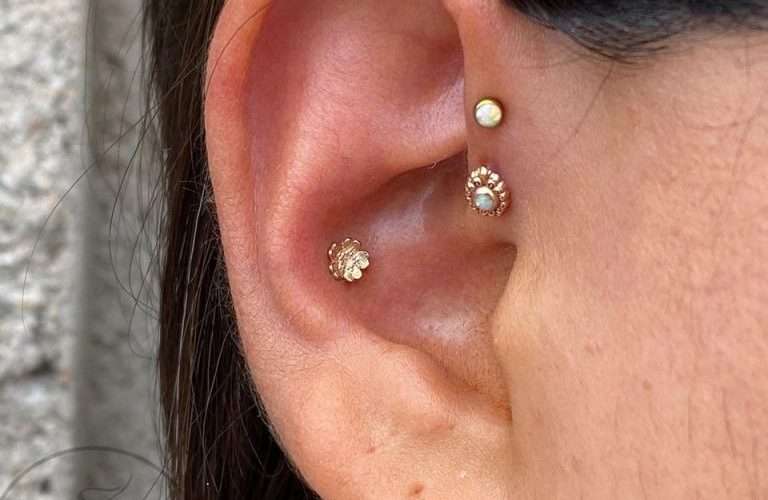For many years, helix piercings—which embellish the upper cartilage of the ear—have been a mainstay in the realm of body modification. However, there has been a recent spike in their appeal, especially when it comes to celebrities and fashion influencers who are spotted wearing a variety of sparkling jewellery on their helix folds. This guide is your one-stop shop for all the information you need to know before jumping into the helix revolution if you’re thinking about participating.
An Overview of Helix Piercings
The helix piercing, which passes through the ear’s upper cartilage, provides a flexible surface for a variety of jewellery designs. A variety of alternatives are possible with this placement, ranging from simple studs to complex constellations of piercings along the fold. While some choose the traditional single helix, others experiment with various designs, such as the forward helix, which pierces the cartilage’s front curve, or the industrial piercing, which consists of two piercings joined by a single barbell.
Pain Point: What to Anticipate
To be honest, getting a piercing requires needles, and needles aren’t exactly comfortable. Pain perception is subjective, though. Most people report feeling a sudden pinch or pressure after getting a helix piercing, which is followed by a dull throbbing that lasts for a few days. The good news is that the discomfort is temporary because the piercing itself usually happens quite quickly.
The following are some variables that may affect how you feel pain:
- Your pain threshold: While some people tremble at the slightest cut, others are made for exhilarating journeys. Being aware of your own threshold will aid in your mental preparation.
- The piercer’s skill: A proficient piercer minimises discomfort by using exact technique and premium equipment.
- Jewellery: The appropriate size and type of jewellery can have a big impact on comfort and healing.
Best Advice: Some piercers give topical anaesthetics to numb the region beforehand if you’re extremely nervous.
Recovering Like a Pro: Essential Aftercare
Like other cartilage piercings, helix piercings usually take three to six months to cure, longer than lobe piercings. A seamless healing process and the prevention of infection depend on proper aftercare. This is a breakdown of your aftercare regimen:
- Cleaning: Use sterile saline solution twice a day to clean your piercing. Steer clear of antibiotic ointments, harsh cleansers, and alcohol since these may irritate the piercing.
- Avoid Touching! Avoid the temptation to tinker with your piercing because our hands are rife with bacteria. This may spread bacteria and slow the healing process.
Watch Out for the Bump: During the healing process, little lumps are typical surrounding the piercing. Avoid picking on them! With the right attention, they normally go away on their own. Should they continue or grow too big, speak with your piercer. - Hair Play: Watch out for tangles in your hair. Try loosely tying your long hair if you have it to prevent unintentionally tugging or straining on the piercing.
- Sleeping Beauty: You might unintentionally aggravate the piercing while you’re asleep. For the first several weeks, try sleeping on the other ear.
- Pay Attention to Your Body: See a physician or a trustworthy piercer right away if you suffer from severe pain, redness, or pus.
Selecting the Ideal Piercer: A Crucial Choice
For a safe and satisfying piercing experience, choosing the appropriate piercer is essential. Here are some important points to remember:
- Reputation: Look up piercers online and read reviews and portfolios, or ask friends for referrals.
- Experience: Look for a piercer who has a track record of successfully completing helix piercings; ideally, they will have knowledge of anatomy and the right aseptic procedures.
- Hygiene: Ensure that the piercing studio is kept tidy and up to date. Needlesticks and sterile equipment are necessary.
- Interaction: Don’t hold back! Inquire about the piercing procedure, the sort of jewellery they use, and the aftercare recommendations. A competent piercer will be pleased to answer your questions and make sure you’re comfortable every step of the way.
Keep in mind: Never have piercings done with piercing guns. Guns can injure cartilage with blunt force, raising the possibility of problems.
Jewellery Selection: Blending Style and Function
For optimal recovery, the jewellery you wore when getting your helix piercing is essential. Your piercer will suggest a premium stud crafted from 14k solid gold or titanium suitable for implants. These materials are less likely to irritate and are biocompatible.
After your piercing has healed completely, you have access to an amazing selection of jewellery. You can choose from traditional studs to hoops, barbells, and elaborate patterns! Here are some more suggestions for choosing jewellery:
- Begin basic: Wait for your piercing to fully heal before attempting a new look.
Make sure the jewellery fits comfortably—not too tight or loose—because size counts. - Material magic: Use hypoallergenic materials alone, such as gold or titanium used in implants, to
For more news click thebritaintimes.co.uk
